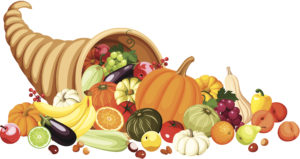
American Thanksgiving is a holiday with very specific roots. When the pilgrims first landed in America and faced incredible hardship, they relied on the indigenous peoples of the country to survive. While the story is quite complicated and much blood was shed as colonial forces began to appear on the shores of North America, Thanksgiving remains a time to reflect upon that which is dearest to the heart. Even though this holiday has its origins planted in the soil of America, many of the traditions related to the event stretch back in history.
Modern celebrations of the holiday center around the founding of America, but the elements involved with this holiday have a lot to do with ancient harvest festivals. From cornucopias to harvest prayers, there are many interesting background stories involved with this day of thanks.
Horn of Plenty
Images related to Thanksgiving usually include turkeys, puritanical costumes, and all sorts of colorful fall foliage. While much of this is connected to the American tale of the holiday, one specific symbol delves into more ancient rituals. The cornucopia, also known as the “horn of plenty,” is a horn-like object filled with fruits, grains, and gourds. Though most homes will use decorative cornucopias as centerpieces for dinner tables, there are many who opt to fill horns with actual produce to add to the authentic look.
The origin of the cornucopia is believed to have pagan roots dating back to ancient Greece. In Greek mythology, Zeus was said to have been breastfed by a goat named Amalthea. In honor of this goat, Greeks would use the symbol of a horn in many festivals. The annual harvest festival, for example, would involve filling a “horn of plenty” with the bounty of the season as a way of showcasing the copious yield. The symbol of the horn is still used in modern pagan festivals throughout the year.
Harvest Home
Since the original Pilgrims came from England before journeying to America, it makes sense many of the original Thanksgiving traditions came from older European celebrations. It is believed the holiday is directly tied to the “Harvest Home” festival that was celebrated in England around this time. This festival was initially a harvest celebration thrown by pagan druids in the English countryside. Though it was a popular event for many Christians, more orthodox groups began to denounce the festival and claim it as a form of Satanic worship.
Though a large number of Puritans banned Harvest Home in the years leading up to the colonization of America, many of the traditions associated with the feast carried on into later celebrations of Thanksgiving. The act of picking a Harvest Queen dates back to Harvest Home practices. Though not as common as it once was, many American celebrations around the autumn involve the selection of a Harvest Queen, often a woman of prominence in the community who will oversee the events of the festival. The Harvest Queen exists to pay tribute to Ceres, the Roman goddess of the harvest.
Central Message
The main idea of Thanksgiving is to stop for a moment and give thanks for what might otherwise be taken for granted throughout the year. People will give thanks for their loved ones, for good fortune, or for events that helped to improve one’s life. This is the same idea that pagans had when celebrating Harvest Home and other early harvest celebrations. In most cases, the main “thanks” being given during these festivals would be a bountiful harvest. When there was a big yield on crops, it meant the upcoming winter would not be as harsh.
Though the holiday is celebrated for many different reasons today, Thanksgiving is simply the newest incarnation in a longstanding celebration of appreciating the good that can come about in life. Finding a reason to be thankful can help to nourish the soul, just as a bountiful harvest can provide sustenance to the body.

